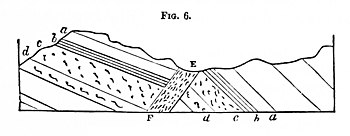disastrous in the tertiary and blue clay on which the ruined portion of the city stood.
The sea-wave put in motion by this earthquake exceeded in volume all others of which we have a record, except the one already noticed, which traversed the Pacific Ocean in 1868. It was observed, during this convulsion, that the sea retired from the shore before the great wave rolled in.
Fig. 5.

Curved Strata, as seen in the Swiss Jura.
It was Darwin who first suggested that waves first draw the waters from the shore on which they are advancing to break. He calls attention to the familiar fact that waves thrown up by the paddles of a steamer, as they approach the shore, are alway preceded by a receding of the water. An under-draught seems to first suck the water back, and such actually is the fact. Now, in the sea-wave raised by the earthquake, what takes place? We have remarked that an
Fig. 6.

Strata broken and displaced.
earthquake is a vibration of the earth's elastic crust, and moves with tremendous velocity. When it occurs beneath the sea, or when the undulations reach the surface beneath the sea, the motion is communicated to the water, which it elevates in a wave. Simultaneously with this lifting of the water, an under-draught toward that point takes place. Were it not so, the elevation of the wave could not be sustained. Directly the great wave moves from the area of disturbance

